Hand mixing your lye soap like Grandma offers precise control over ingredients, creating a meditative experience that connects you to generations of soapmakers. You'll gain deeper satisfaction from the traditional process while developing expertise in recognizing the perfect trace. This method reduces energy use, eliminates harsh chemicals, and allows you to customize bars for different skin types. Follow along to discover why this time-honored craft might become your favorite self-care ritual.
The Time-Honored Tradition of Manual Soap Crafting
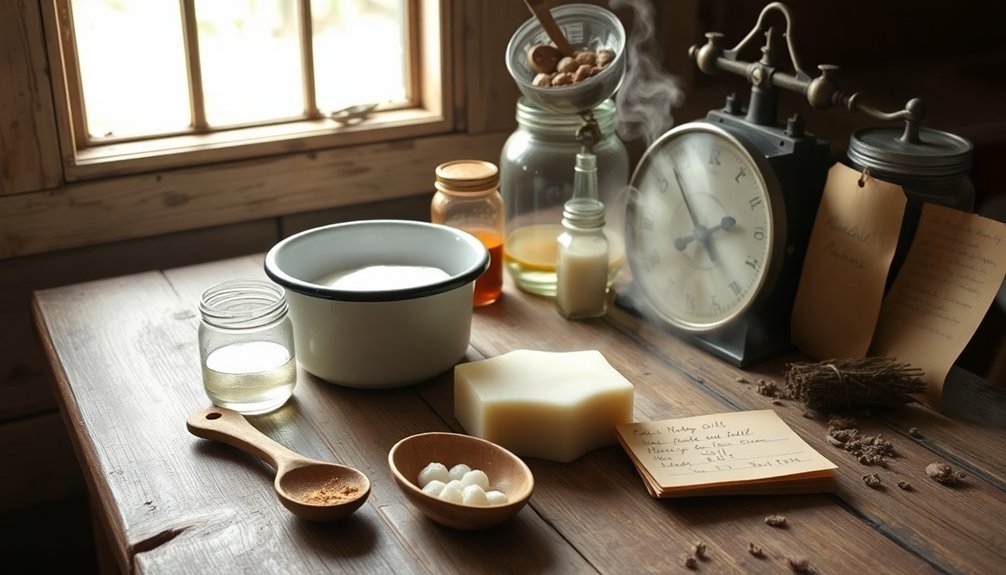
While modern soap making equipment offers convenience, hand mixing represents the authentic soul of soap crafting. When you measure and mix ingredients by hand, you gain precise control over your soap's composition and texture that machines simply can't replicate.
There's something deeply satisfying about adjusting your recipe on the fly—adding more color here, tweaking an additive there—all based on your developing expertise. Many crafters find the rhythmic stirring process meditative and therapeutic, creating a mindful escape from daily stress. However, achieving proper emulsification without a stick blender will require significantly more time and physical effort.
You'll also save considerably on equipment costs while preserving traditional techniques that have produced quality soap for generations.
These time-honored methods connect you to a rich heritage of craftsmanship that modern manufacturing has largely abandoned.
Connecting With Our Soapmaking Ancestors
As you stand over your mixing bowl carefully blending your soap ingredients, you're participating in a ritual that spans countless generations. Your ancestors leached lye from hardwood ashes and rainwater, transforming animal fats into practical cleansers using minimal equipment.
When you hand mix soap, you're not just making a product—you're continuing a cultural tradition that fosters connection between generations. The patience required mirrors the unhurried values of earlier times. Each stirring motion links you to those who gathered in communal settings to craft soap from local resources. For safety, always add lye to liquid rather than the reverse to prevent dangerous splashing reactions.
This practice preserves more than techniques; it maintains cultural heritage. By embracing these traditional methods, you're keeping alive the wisdom and resourcefulness of your forebears while creating something genuinely authentic for today's world.
Essential Tools for Hand-Mixed Lye Soap
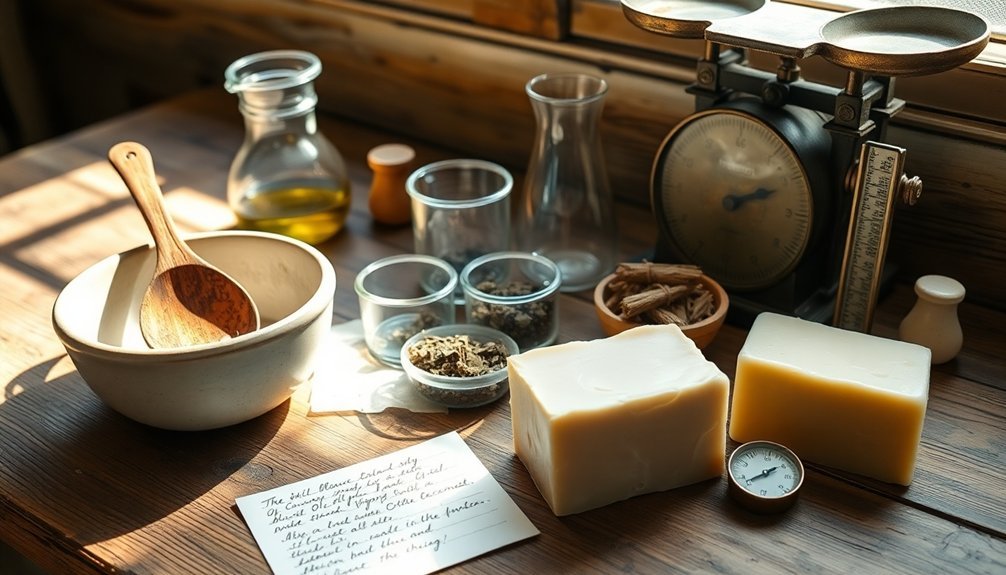
Hand mixing soap requires more than just ancestral knowledge—it demands practical tools that guarantee both safety and quality. Your safety equipment should never be compromised: always use rubber gloves, protective goggles, and appropriate clothing to shield yourself from lye's caustic nature.
| Category | Essential Items | Why It Matters |
|---|---|---|
| Safety | Goggles, Gloves, Long Sleeves | Prevents lye burns |
| Mixing | Stainless Steel Spoon, Spatula | Resists lye corrosion |
| Measuring | Digital Scale, Measuring Cups | Secures precise ratios |
| Containers | Heat-resistant Glass, Stainless Steel | Handles temperature changes |
| Emergency | Vinegar, Paper Towels | Neutralizes accidental spills |
While modern soapmakers might reach for an immersion blender, hand mixing with a wooden or stainless steel spoon connects you to traditional methods while still producing excellent results. When using liquid ingredients, aim for both lye solution and oils to be approximately 100°F (38°C) to ensure proper emulsification during the mixing process. Your molds can be simple wooden boxes lined with parchment paper—authentically old-fashioned yet perfectly functional.
Achieving the Perfect Trace Without Electricity
Achieving trace without electrical equipment depends on your ability to recognize visual cues and understand physical texture changes through hands-on mixing.
You'll need to maintain proper temperature, typically between 135-145°F, which greatly impacts how quickly your oils and lye emulsify into soap.
Selecting recipes with higher saturated fats like coconut oil, palm oil, or tallow will significantly reduce the time needed to reach trace when hand stirring.
Visual Control and Precision
When creating soap by hand, how do you know exactly when your mixture has reached the perfect trace?
Unlike stick blenders, hand mixing gives you unparalleled visual control over the saponification process. You'll notice subtle changes in consistency and texture that mechanical methods might rush past.
Watch for slight thickening as you stir – when your mixture leaves a faint trail on the surface (like cake batter), you've reached light trace. Hand stirring requires more patience but can result in a smoother mixture compared to stick blending which might introduce air bubbles.
The drizzle test is your best friend: lift your spoon and let soap drip onto the surface. If it sits momentarily before sinking, you're there.
This precision allows you to add fragrances at exactly the right moment, avoiding seizing or ricing.
You're not racing against the clock of a mechanical device – you're responding to what your soap actually needs.
Physical Texture Awareness
The art of soap making becomes truly intimate as you develop physical texture awareness through your hands and basic tools. When you manually mix with spatulas or wooden spoons, you'll feel every nuance of the saponification process, recognizing different trace stages through tactile feedback.
| Texture Stage | What You'll Feel |
|---|---|
| Light Trace | Slightly thickened, leaves faint trail |
| Medium Trace | Pudding-like, holds pattern briefly |
| Thick Trace | Holds shape, similar to cake batter |
| Very Thick | Stands up like whipped cream |
| Seized | Too thick to pour, moldable like clay |
Without electric mixers rushing the process, you'll gain better control over consistency. You'll notice how different oils affect texture—coconut creates hardness while olive produces softness. The saponification values of your chosen fats directly influence how quickly your mixture reaches trace and its final texture. This heightened awareness lets you adapt in real-time, reducing over-mixing and allowing for creative customization.
Soap Temperature Management
Successful soap temperature management remains one of the most essential yet challenging aspects of hand-mixed soap making.
Without electricity, you'll need to master the heat transfer method, using the natural heat from your lye solution to melt harder oils and butters.
Aim for that sweet spot between 120°F and 130°F when combining your lye and oils. Too hot, and you'll accelerate saponification, limiting design options. Too cool, and you risk false trace where oils solidify before properly emulsifying.
Different ingredients respond uniquely to temperature—coconut oil melts at 76°F while cocoa butter needs 93°F. Remember that when properly mixed, lye water can reach extremely high temperatures of around 200°F, providing ample heat for melting your hard oils.
The Meditative Benefits of Slow Stirring
You'll find that slow stirring by hand creates a natural rhythm that can shift your mind into a meditative state, bringing awareness to each movement and sensation.
The repetitive stirring motion naturally encourages slow breathing, which activates your body's relaxation response and reduces stress as you work.
As you focus on the consistent motion, you'll often enter a creative flow state where time seems to slow and your thoughts become clearer.
This deliberate process connects you not only to the craft itself but also to generations of soap makers who found similar moments of peace in this simple yet profound activity.
Mindful Stirring Awareness
Mindful stirring transforms a simple household task into a meditative practice with profound benefits for your mental well-being. By focusing completely on the rhythmic motion of mixing lye, you'll engage in a form of meditation that calms your mind while completing necessary work.
When you practice mindful stirring, you'll experience:
- Enhanced focus and clarity – The repetitive motion centralizes your attention, reducing mental clutter.
- Physical relaxation – Your muscles release tension as you fall into a natural rhythm.
- Emotional balance – The practice decreases anxiety and reactivity while promoting self-compassion.
This ancestral approach isn't just about making soap—it's about reconnecting with yourself. Research shows that engaging in this moment-to-moment awareness while stirring can significantly improve your working memory capacity and attention.
Your grandmother likely knew intuitively what science now confirms: mindful stirring combines practicality with powerful cognitive and emotional benefits.
Finding Creative Flow
While working with lye, slow stirring creates a unique mental space where creativity and meditation converge naturally.
You'll notice your mind entering a flow state as the repetitive motion establishes a calming rhythm. This pattern recognition allows your subconscious to emerge, often bringing unexpected insights and solutions to unrelated problems.
As you stir, you're not just making soap—you're engaging in a practice that reduces blood pressure, lowers heart rate, and balances stress hormones. This meditative process shifts your brain activity to slower wave states, similar to what occurs during traditional meditation practices.
The focused attention required keeps you anchored in the present moment, engaging your senses fully through the tactile experience. Your breathing naturally synchronizes with your stirring, further deepening your mindfulness.
This accessible form of meditation doesn't require special training or settings—just you, a spoon, and the willingness to slow down.
Connection Through Process
The gentle rhythm of stirring lye creates a unique form of connection—not just with the materials in your bowl, but with yourself and those who've practiced this art before you.
You'll notice your senses fully engaged as you observe color changes, feel consistency shifts, and inhale the subtle aromas of your creation.
This meditative process activates your parasympathetic nervous system, bringing a natural calm that's increasingly rare in our fast-paced world. Research shows that repetitive motions like stirring can help reduce chronic pain similarly to traditional meditation practices.
When you mix by hand, you're practicing mindfulness without even trying.
- Your body benefits through improved circulation and reduced blood pressure
- Your mind finds clarity through focused, repetitive motion
- Your spirit connects to generations of soap makers who've stirred these same ingredients
It's not just soap making—it's soul making.
Safety First: Handling Lye the Traditional Way
Before diving into the art of traditional lye making, you'll need to establish proper safety protocols to protect yourself from this caustic substance.
Always wear protective clothing—long sleeves, pants, closed-toe shoes—along with rubber gloves and eye goggles to minimize exposure risks.
Set up your workspace with good ventilation near a water source. Keep it clean, distraction-free, and equipped for spill containment.
When mixing, use glass or stainless steel containers, never aluminum. Always add lye to water—never reverse the order—and stir thoroughly to prevent dangerous exothermic reactions that can reach up to 200° F.
Store your lye in original, clearly labeled containers in cool, dry places away from children and pets.
If accidental exposure occurs, immediately rinse with running water and seek medical attention for severe burns.
Selecting Oils That Work Best for Hand Mixing
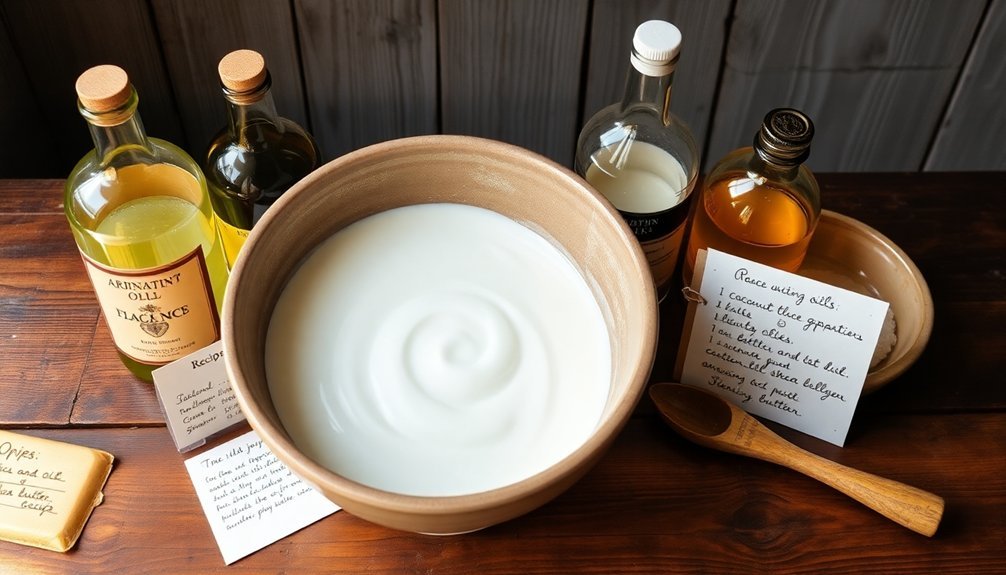
Selecting the right oils forms the foundation of successful hand-mixed lye soap. When using traditional hand-mixing methods rather than stick blenders, you'll want oils that reach trace within a reasonable timeframe without exhausting your arm muscles.
Coconut oil and palm oil work beautifully for hand mixing because they promote faster saponification and create harder bars. Olive oil, while slower to trace, provides essential moisturizing properties for balanced soap. The ideal recipe should contain oils with balanced fatty acids to ensure the final product has the perfect combination of cleansing and moisturizing qualities.
Consider these combinations for hand-mixing success:
- 50% olive oil + 30% coconut oil + 20% palm oil – A balanced formula that reaches trace within 20-30 minutes of hand stirring
- 60% olive oil + 30% coconut oil + 10% castor oil – Excellent for beginners with manageable stirring time
- 40% olive oil + 30% coconut oil + 20% palm oil + 10% sweet almond oil – Creates luxurious bars with moderate hand-mixing effort
Troubleshooting Common Hand-Mixed Soap Issues
Even with the perfect oil combination, hand-mixed soap can sometimes present challenges that test your patience.
When your soap separates or curdles, it's likely due to temperature imbalance—keep your oils and lye solution within 10°F of each other for ideal mixing.
If you're experiencing a "fake trace" where your soap appears thick but later separates, your mixture may be too cool. Consider gentle reheating.
For grainy textures, applying heat post-mixing can smooth things out.
When your soap cracks or becomes brittle, you've likely used too much lye or not enough water.
Test your soap's pH or perform the "zap test" to check for residual lye. Most issues can be resolved by remelting and adjusting your recipe.
Always cross-check measurements before starting—prevention trumps correction.
Using a postal scale to weigh your ingredients rather than measuring by volume will significantly improve your soap recipe's accuracy and final product quality.
The Environmental Benefits of Unplugged Soapmaking
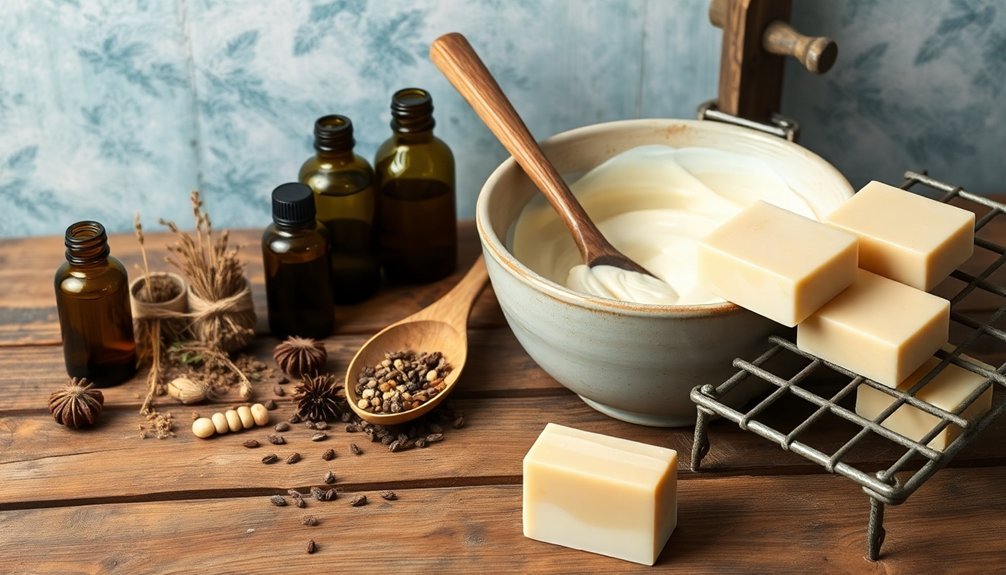
When you make soap by hand, you're participating in one of the most environmentally friendly crafting traditions available today.
By skipping electric mixers and embracing manual methods, you're reducing energy consumption while creating biodegradable products that won't harm our waterways. The zero-toxin production process ensures that no harmful chemicals are released during manufacturing.
Hand-mixed soap making delivers remarkable environmental benefits:
- Reduced carbon footprint – With minimal machinery and low-temperature processes, you'll use considerably less energy than industrial production methods.
- Less packaging waste – Your homemade soaps can be stored and gifted with minimal or biodegradable packaging.
- Support for sustainable ingredients – You control your supply chain, choosing ethically sourced plant oils and natural fragrances that break down safely in the environment.
From Simple Ingredients to Luxurious Bars: The Transformation
The magic of soapmaking lies in its remarkable alchemy – transforming simple pantry oils and a powerful chemical into something entirely new.
Your careful selection of olive oil, coconut oil, or shea butter determines whether your final bar will cleanse, moisturize, or soothe sensitive skin.
As you hand-mix these oils with your precisely measured lye solution, you'll witness the miraculous process of saponification taking place.
This careful dance of temperatures (ideally 90-110°F) and stirring techniques brings your mixture to "trace" – the moment when oils and lye fully combine.
After pouring into your chosen mold, patience becomes your virtue.
The initial setting takes hours, but true transformation happens during the weeks-long curing process, when your simple ingredients finally become luxurious, long-lasting soap bars.
Customizing Your Hand-Mixed Soap for Different Skin Needs
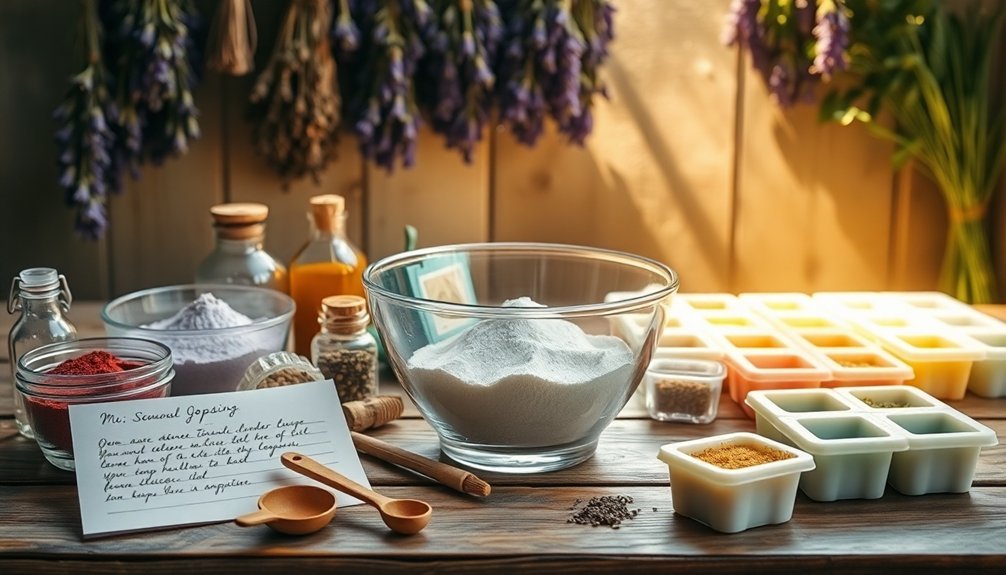
Every skin type demands specific ingredients to truly thrive, making customization the true art of handcrafted soapmaking.
When you hand mix your own lye soap, you'll control exactly what touches your skin, eliminating harsh chemicals found in commercial products.
For ideal results with different skin types:
- Oily or acne-prone skin – Choose glycerin or olive oil bases with tea tree oil and eucalyptus to regulate oil production and fight bacteria.
- Dry, sensitive skin – Incorporate shea butter or goat milk bases with natural moisturizers like glycerin to retain hydration.
- Mature skin – Add rosehip oil to promote elasticity and reduce fine lines, while using gentle exfoliants like oatmeal for rejuvenation.
The saponification process transforms these carefully selected ingredients into bars perfectly suited to your specific needs.
Frequently Asked Questions
Can Hand-Mixed Lye Soap Be Used Immediately After Making?
No, you can't use hand-mixed lye soap immediately. Your soap needs time to complete saponification (about 48 hours) and should cure for four weeks to become milder and longer-lasting before it's safe to use.
How Long Do Hand-Mixed Soaps Typically Last Compared to Store-Bought?
Your hand-mixed soaps typically last 1-2 years, while store-bought versions can last 2-10 years. This difference occurs because commercial soaps contain preservatives, while your natural homemade soaps are more vulnerable to environmental factors.
Can I Substitute Lye With Another Ingredient for Safer Handling?
No, you can't substitute lye in true soapmaking. For safer handling, try melt-and-pour bases where someone else has already completed the lye process. These pre-made bases let you customize without handling caustic chemicals yourself.
Will Temperature Changes in My Home Affect the Hand-Mixing Process?
Yes, temperature fluctuations in your home will affect hand-mixing soap. You'll notice oils solidify faster in cold rooms and mix too quickly in warm ones. Always monitor temperatures with a thermometer for consistent results.
Do Certain Fragrances or Additives Interfere With Hand-Mixed Lye Reactions?
Yes, some fragrances and additives can interfere with lye reactions. Niacinamide releases ammonia fumes, while certain essential oils may accelerate or inhibit saponification. Always research compatibility before adding anything to your lye mixture.
In Summary
By hand-mixing your lye soap like Grandma did, you're not just making cleanser—you're preserving history. You'll find joy in the rhythmic stirring, develop intuition about perfect trace, and create truly personalized products. There's something deeply satisfying about crafting soap with your own hands that no electric mixer can match. So grab your wooden spoon and connect with generations past through this timeless, therapeutic art.

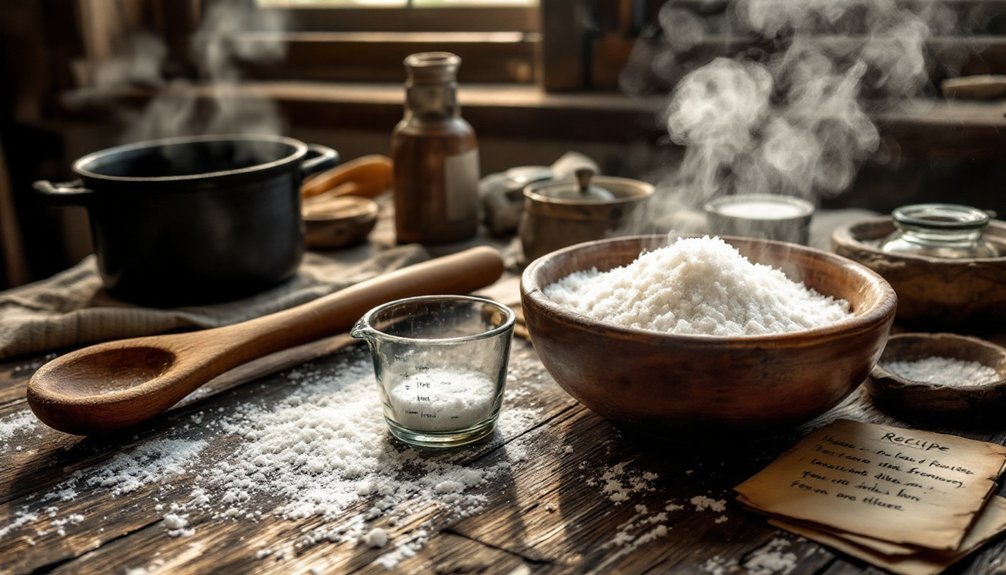



Leave a Reply